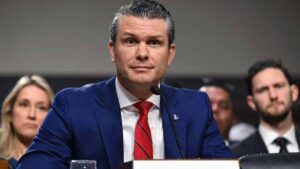Biden’s Billion-Dollar Gamble Stuns the Nation as Experts Reveal Disturbing Implications for Kids

Credit: Getty Images
In a move that has left the nation both stunned and divided, President Joe Biden has embarked on what many are calling a billion-dollar gamble aimed at safeguarding the health and safety of children in public schools. With billions of dollars funneled into replacing lead pipes and millions more dedicated to improving indoor air quality, the administration’s bold initiative has sparked widespread debate.
While the intention behind these investments is clear—ensuring that children can focus on learning without the fear of contaminated water or polluted air—experts are now raising disturbing implications that suggest the gamble might carry unintended consequences for the very students it seeks to protect. The Biden administration’s latest educational infrastructure overhaul represents one of the most significant investments in public health and school safety in recent history.
According to a tweet posted on his X (formerly twitter) handle on Wednesday, August 28, 2024, President Biden proclaimed, “Our kids deserve to focus on learning without worrying that their school’s air and water might not be safe. That’s why my Administration has invested billions to replace lead pipes and millions to help schools in disadvantaged communities manage indoor air quality.”
This announcement marks a continuation of Biden’s broader agenda to modernize America’s crumbling infrastructure, particularly in low-income and marginalized communities that have historically borne the brunt of environmental neglect.
However, as the details of the plan began to emerge, so too did the concerns. Experts in public health, education, and infrastructure have voiced a range of issues, many of which underscore the complexities and potential pitfalls of implementing such a sweeping initiative. While the goals of the program are laudable, the logistics of replacing lead pipes across thousands of schools and upgrading ventilation systems to modern standards are daunting, to say the least. Critics worry that the scale and speed of the project could lead to unforeseen complications, ultimately affecting the very children it is intended to protect.
One of the most alarming concerns revolves around the potential for disruption during the implementation phase. Schools in disadvantaged communities are often already under-resourced, and the addition of large-scale construction projects could further strain these institutions.
Replacing lead pipes, for instance, is not a simple process. It requires extensive excavation, which could lead to the temporary closure of schools or sections of schools, displacing students and disrupting their education. Similarly, upgrading air quality systems involves not only the installation of new equipment but also the removal of outdated systems, which can expose students and staff to dust, mold, and other allergens if not handled properly.
A Twitter user, echoing this sentiment, replied to Biden’s announcement with a note of caution: “You’ve destroyed the public schools. People are fleeing it in droves to private schools and homeschooling.” This response highlights a growing frustration among parents who feel that public schools are already failing their children and that this new initiative could exacerbate existing problems rather than solve them.
Another Twitter user replied,” Our kids deserve to grow up in a country where their vote counts as one”.
Moreover, some experts are concerned about the long-term sustainability of the investments. While billions of dollars have been allocated to address these critical infrastructure issues, questions remain about the ongoing maintenance and support required to ensure these improvements last.
Lead pipes, for example, have been a problem in American infrastructure for decades, and while replacing them is essential, ensuring that new systems are maintained and that water quality is consistently monitored will require additional resources that may not be accounted for in the initial funding. Without a clear plan for the future, there is a risk that these improvements could be short-lived, leaving schools vulnerable to the same issues a few years down the line.
Despite these concerns, there is also significant support for the initiative. Many believe that Biden’s investment is a necessary step toward rectifying long-standing inequities in the public school system. Another Twitter user responded to the announcement, saying, “It’s crucial that our children learn in environments free from health hazards.
Investing billions to replace lead pipes and millions to improve air quality in schools is a significant step towards ensuring their safety and well-being. Let’s continue to support and expand these efforts to guarantee every school has the resources needed for a safe and healthy learning environment. Our kids deserve nothing less.”
This perspective reflects a broader understanding of the challenges facing disadvantaged communities. Schools in these areas have often been left behind in terms of infrastructure and resources, leading to a host of health issues that disproportionately affect children from low-income families. By addressing the root causes of these problems—unsafe drinking water and poor air quality—Biden’s administration is taking direct action to improve the lives of these students.
However, the success of this billion-dollar gamble will ultimately depend on how well it is executed. If the administration can effectively manage the logistics of these massive infrastructure projects while minimizing disruption to students and ensuring long-term sustainability, it could mark a turning point for public education in America. On the other hand, if the challenges raised by experts are not adequately addressed, the initiative could fall short of its goals, leaving schools and students worse off than before.





